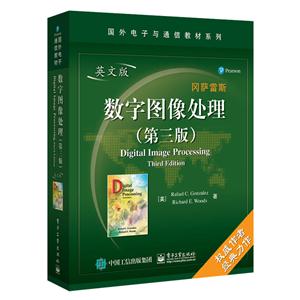-
>
闖進數學世界――探秘歷史名題
-
>
中醫基礎理論
-
>
當代中國政府與政治(新編21世紀公共管理系列教材)
-
>
高校軍事課教程
-
>
思想道德與法治(2021年版)
-
>
毛澤東思想和中國特色社會主義理論體系概論(2021年版)
-
>
中醫內科學·全國中醫藥行業高等教育“十四五”規劃教材
數字圖像處理-(第三版)-英文版 版權信息
- ISBN:9787121305405
- 條形碼:9787121305405 ; 978-7-121-30540-5
- 裝幀:暫無
- 冊數:暫無
- 重量:暫無
- 所屬分類:>>
數字圖像處理-(第三版)-英文版 本書特色
本書是關于數字圖像處理的經典著作,作者在對32個國家的134所院校和研究所的教師、學生及自學者進行廣泛調查的基礎上編寫了第三版。除保留第二版的大部分主要內容外,還根據收集的建議從13個方面進行了修訂,新增了400多幅圖像、200多個圖表和80多道習題,同時融入了近年來本科學領域的重要發展,使本書具有鮮明的特色與時效性。全書共分12章,包括緒論、數字圖像基礎、灰度變換與空間濾波、頻域濾波、圖像復原與重建、彩色圖像處理、小波及多分辨率處理、圖像壓縮、形態學圖像處理、圖像分割、表現與描述、目標識別。
數字圖像處理-(第三版)-英文版 內容簡介
本書是數字圖像處理的經典教材,內容涵蓋數字圖像基礎、灰度變換與空間濾波、頻率域濾波、圖像復原與重建、彩色圖像處理、小波和多分辨率處理、圖像壓縮、形態學圖像處理、圖像分割、表示與描述、目標識別等,全球近700所高校采用為教材。
數字圖像處理-(第三版)-英文版 目錄
Acknowledgments 19
The Book Web Site 20
About the Authors 21
Chapter 1 Introduction 23
1.1 What Is Digital Image Processing? 23
1.2 The Origins of Digital Image Processing 25
1.3 Examples of Fields that Use Digital Image Processing 29
1.3.1 Gamma-Ray Imaging 30
1.3.2 X-Ray Imaging 31
1.3.3 Imaging in the Ultraviolet Band 33
1.3.4 Imaging in the Visible and Infrared Bands 34
1.3.5 Imaging in the Microwave Band 40
1.3.6 Imaging in the Radio Band 42
1.3.7 Examples in which Other Imaging Modalities Are Used 42
1.4 Fundamental Steps in Digital Image Processing 47
1.5 Components of an Image Processing System 50
Summary 53
References and Further Reading 53
Chapter 2 Digital Image Fundamentals 57
2.1 Elements of Visual Perception 58
2.1.1 Structure of the Human Eye 58
2.1.2 Image Formation in the Eye 60
2.1.3 Brightness Adaptation and Discrimination 61
2.2 Light and the Electromagnetic Spectrum 65
2.3 Image Sensing and Acquisition 68
2.3.1 Image Acquisition Using a Single Sensor 70
2.3.2 Image Acquisition Using Sensor Strips 70
2.3.3 Image Acquisition Using Sensor Arrays 72
2.3.4 A Simple Image Formation Model 72
2.4 Image Sampling and Quantization 74
2.4.1 Basic Concepts in Sampling and Quantization 74
2.4.2 Representing Digital Images 77
2.4.3 Spatial and Intensity Resolution 81
2.4.4 Image Interpolation 87
2.5 Some Basic Relationships between Pixels 90
2.5.1 Neighbors of a Pixel 90
2.5.2 Adjacency, Connectivity, Regions, and Boundaries 90
2.5.3 Distance Measures 93
2.6 An Introduction to the Mathematical Tools Used in Digital Image Processing 94
2.6.1 Array versus Matrix Operations 94
2.6.2 Linear versus Nonlinear Operations 95
2.6.3 Arithmetic Operations 96
2.6.4 Set and Logical Operations 102
2.6.5 Spatial Operations 107
2.6.6 Vector and Matrix Operations 114
2.6.7 Image Transforms 115
2.6.8 Probabilistic Methods 118
Summary 120
References and Further Reading 120
Problems 121
Chapter 3 Intensity Transformations and Spatial Filtering 126
3.1 Background 127
3.1.1 The Basics of Intensity Transformations and Spatial Filtering 127
3.1.2 About the Examples in This Chapter 129
3.2 Some Basic Intensity Transformation Functions 129
3.2.1 Image Negatives 130
3.2.2 Log Transformations 131
3.2.3 Power-Law (Gamma) Transformations 132
3.2.4 Piecewise-Linear Transformation Functions 137
3.3 Histogram Processing 142
3.3.1 Histogram Equalization 144
3.3.2 Histogram Matching (Specification) 150
3.3.3 Local Histogram Processing 161
3.3.4 Using Histogram Statistics for Image Enhancement 161
3.4 Fundamentals of Spatial Filtering 166
3.4.1 The Mechanics of Spatial Filtering 167
3.4.2 Spatial Correlation and Convolution 168
3.4.3 Vector Representation of Linear Filtering 172
3.4.4 Generating Spatial Filter Masks 173
3.5 Smoothing Spatial Filters 174
3.5.1 Smoothing Linear Filters 174
3.5.2 Order-Statistic (Nonlinear) Filters 178
3.6 Sharpening Spatial Filters 179
3.6.1 Foundation 180
3.6.2 Using the Second Derivative for Image Sharpening-The Laplacian 182
3.6.3 Unsharp Masking and Highboost Filtering 184
3.6.4 Using First-Order Derivatives for (Nonlinear) Image Sharpening—The Gradient 187
3.7 Combining Spatial Enhancement Methods 191
3.8 Using Fuzzy Techniques for Intensity Transformations and Spatial Filtering 195
3.8.1 Introduction 195
3.8.2 Principles of Fuzzy Set Theory 196
3.8.3 Using Fuzzy Sets 200
3.8.4 Using Fuzzy Sets for Intensity Transformations 208
3.8.5 Using Fuzzy Sets for Spatial Filtering 211
Summary 214
References and Further Reading 214
Problems 215
Chapter 4 Filtering in the Frequency Domain 221
4.1 Background 222
4.1.1 A Brief History of the Fourier Series and Transform 222
4.1.2 About the Examples in this Chapter 223
4.2 Preliminary Concepts 224
4.2.1 Complex Numbers 224
4.2.2 Fourier Series 225
4.2.3 Impulses and Their Sifting Property 225
4.2.4 The Fourier Transform of Functions of One Continuous Variable 227
4.2.5 Convolution 231
4.3 Sampling and the Fourier Transform of Sampled Functions 233
4.3.1 Sampling 233
4.3.2 The Fourier Transform of Sampled Functions 234
4.3.3 The Sampling Theorem 235
4.3.4 Aliasing 239
4.3.5 Function Reconstruction (Recovery) from Sampled Data 241
4.4 The Discrete Fourier Transform (DFT) of One Variable 242
4.4.1 Obtaining the DFT from the Continuous Transform of a Sampled Function 243
4.4.2 Relationship Between the Sampling and Frequency Intervals 245
4.5 Extension to Functions of Two Variables 247
4.5.1 The 2-D Impulse and Its Sifting Property 247
4.5.2 The 2-D Continuous Fourier Transform Pair 248
4.5.3 Two-Dimensional Sampling and the 2-D Sampling Theorem 249
4.5.4 Aliasing in Images 250
4.5.5 The 2-D Discrete Fourier Transform and Its Inverse 257
4.6 Some Properties of the 2-D Discrete Fourier Transform 258
4.6.1 Relationships Between Spatial and Frequency Intervals 258
4.6.2 Translation and Rotation 258
4.6.3 Periodicity 259
4.6.4 Symmetry Properties 261
4.6.5 Fourier Spectrum and Phase Angle 267
4.6.6 The 2-D Convolution Theorem 271
4.6.7 Summary of 2-D Discrete Fourier Transform Properties 275
4.7 The Basics of Filtering in the Frequency Domain 277
4.7.1 Additional Characteristics of the Frequency Domain 277
4.7.2 Frequency Domain Filtering Fundamentals 279
4.7.3 Summary of Steps for Filtering in the Frequency Domain 285
4.7.4 Correspondence Between Filtering in the Spatial and Frequency Domains 285
4.8 Image Smoothing Using Frequency Domain Filters 291
4.8.1 Ideal Lowpass Filters 291
4.8.2 Butterworth Lowpass Filters 295
4.8.3 Gaussian Lowpass Filters 298
4.8.4 Additional Examples of Lowpass Filtering 299
4.9 Image Sharpening Using Frequency Domain Filters 302
4.9.1 Ideal Highpass Filters 303
4.9.2 Butterworth Highpass Filters 306
4.9.3 Gaussian Highpass Filters 307
4.9.4 The Laplacian in the Frequency Domain 308
4.9.5 Unsharp Masking, Highboost Filtering, and High-Frequency-Emphasis Filtering 310
4.9.6 Homomorphic Filtering 311
4.10 Selective Filtering 316
4.10.1 Bandreject and Bandpass Filters 316
4.10.2 Notch Filters 316
4.11 Implementation 320
4.11.1 Separability of the 2-D DFT 320
4.11.2 Computing the IDFT Using a DFT Algorithm 321
4.11.3 The Fast Fourier Transform (FFT) 321
4.11.4 Some Comments on Filter Design 325
Summary 325
References and Further Reading 326
Problems 326
Chapter 5 Image Restoration and Reconstruction 333
5.1 A Model of the Image Degradation/Restoration Process 334
5.2 Noise Models 335
5.2.1 Spatial and Frequency Properties of Noise 335
5.2.2 Some Important Noise Probability Density Functions 336
5.2.3 Periodic Noise 340
5.2.4 Estimation of Noise Parameters 341
5.3 Restoration in the Presence of Noise Only—Spatial Filtering 344
5.3.1 Mean Filters 344
5.3.2 Order-Statistic Filters 347
5.3.3 Adaptive Filters 352
5.4 Periodic Noise Reduction by Frequency Domain Filtering 357
5.4.1 Bandreject Filters 357
5.4.2 Bandpass Filters 358
5.4.3 Notch Filters 359
5.4.4 Optimum Notch Filtering 360
5.5 Linear, Position-Invariant Degradations 365
5.6 Estimating the Degradation Function 368
5.6.1 Estimation by Image Observation 368
5.6.2 Estimation by Experimentation 369
5.6.3 Estimation by Modeling 369
5.7 Inverse Filtering 373
5.8 Minimum Mean Square Error (Wiener) Filtering 374
5.9 Constrained Least Squares Filtering 379
5.10 Geometric Mean Filter 383
5.11 Image Reconstruction from Projections 384
5.11.1 Introduction 384
5.11.2 Principles of Computed Tomography (CT) 387
5.11.3 Projections and the Radon Transform 390
5.11.4 The Fourier-Slice Theorem
數字圖像處理-(第三版)-英文版 作者簡介
Rafael C. Gonzalez(拉婓爾.岡薩雷斯):美國田納西大學電氣和計算機工程系教授、田納西大學圖像和模式分析實驗室、機器人和計算機視覺實驗室創始人、IEEE會士,研究領域為模式識別、圖像處理和機器人,其著作已被全球范圍內的600多所大學和研究所采用。
Richard E. Woods 美國田納西大學電氣工程系博士,IEEE會員。
- >
苦雨齋序跋文-周作人自編集
- >
小考拉的故事-套裝共3冊
- >
龍榆生:詞曲概論/大家小書
- >
巴金-再思錄
- >
月亮虎
- >
姑媽的寶刀
- >
名家帶你讀魯迅:故事新編
- >
上帝之肋:男人的真實旅程


















